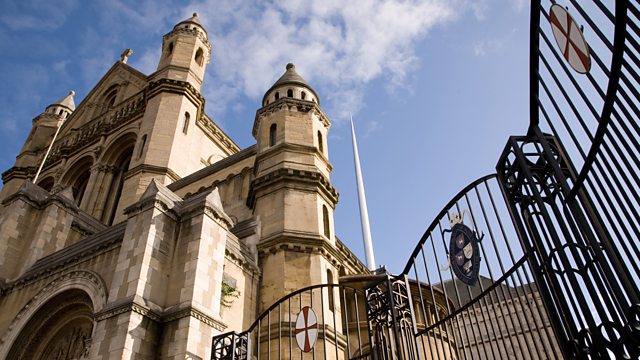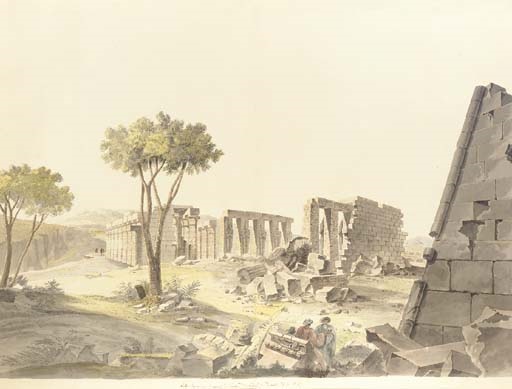Son of Protagoras
by Peter Rollins
I'm currently working on my upcoming Atheism for Lent practice, and one of the reflections is from the ancient Greek philosopher Protagoras. It reminded me of a powerful piece of graffiti that you can see in Belfast, N.Ireland (if you've been to WAKE you'll likely have seen it on our graffiti tour). It's called Son of Protagoras and was painted by the famous French Graffiti artist MTO. The large and brooding figure is located right across the road from St Anne’s Cathedral. The angry gaze of the son of Protagoras is directed at cathedral, which can be seen through a gap in some buildings.
The figure cradles a dead dove that has been pierced by two arrows bearing the cross of the Knights of Malta and the Latin cross. The artist made this work as a comment on the conflict that once raged between Irish Catholic nationalists and the Protestant unionists. A conflict that was bound up in religious identity.
The piece is rich with powerful symbolism. A dove - representing peace - has been killed by two arrows - representing the Protestant and Catholic sides of the divide. The son of Protagoras looks with anger at the Cathedral, which represents institutional religion.
One of the things that interests me most about this piece (which I'll include as supplemental material in AfL) is the way that it's located across from the Cathedral. As you stand there viewing it, you find yourself midway between the Cathedral and the figure. If the building can be seen as representative of the priest, then the artwork symbolizes the fiery prophet. One is concerned with protecting the accumulated wisdom and rituals of the ages, the other is concerned with pointing out how they turn dogmatic and destructive.
While we might be find ourselves more often closer to one of these sides than the other, standing between them is a good reminder of how these two figures are intertwined, and how we must allow space for both.
The video I've included allows you to explore the artwork by dragging your mouse across the screen. I've also included two pictures of St Anne’s Cathedral.
* * * * * * * * * * *
St Anne’s Cathedral, also known as Belfast Cathedral, is a cathedral of the Church of Ireland in Belfast, Northern Ireland. It is unusual in serving two separate dioceses Connor and Down and Dromore, and is the focal point of the Cathedral Quarter in Northern Ireland’s capital city
 |
| St. Anne's Church, Belfast, Northern Ireland |
 |
| St. Anne's Church, Belfast, Northern Ireland |
"Songs Of Praise Saint Anne's Cathedral Belfast" - Broadcasted on Pentecost (Whit Sunday) 7th June 1981 on BBC One. Even though the cathedral's foundation stone was laid in 1899, the cathedral was completed in phases around where the old church stood. Interruptions by the world wars and "the troubles" caused many delays. It was not until 1981, the whole cathedral fabric could be dedicated, and "Songs of Praise" was broadcast to celebrate the event.
* * * * * * * * * * *
"The Son of PROTAGORAS"
by MTO
International artist, MTO was in Belfast recently attending the “Hit the north”, Culture night and created this inspirational mural as a way of passing his message to the local community. Titled as ”The son of Protagoras”, MTO, brings some indirect mythology to offer his position on human conflict. A true masterpiece!
Located in the yard of “Northern Ireland War Memorial,”
21 Talbot Street, BELFAST, NORTH IRELAND.
The peace lines or peace walls are a series of border barriers in Northern Ireland that separate Irish nationalist and unionist neighbourhoods. They have been built at urban interface areas in Belfast, Derry, Portadown and elsewhere. The stated purpose of the peace lines is to minimise inter-communal violence between Catholics (most of whom are nationalists who self-identify as Irish) and Protestants (most of whom are unionists who self-identify as British).
Protagoras was a proponent of agnosticism. he wrote: “Concerning the gods, I have no means of knowing whether they exist or not or of what sort they may be, because of the obscurity of the subject, and the brevity of human life.”
 |
| Son of Protagoras by MTO, Belfast Art Show |
* * * * * * * * * * *
MTO ’s work is mostly known and characterized by incredibly detailed renditions of famous and cult-y actors and musicians with a dash of red as his signature usually on a red outline of his work. It also works well as a boundary. He has launched a series of projects in the US and Europe. He has managed to reinvent his style and content by stepping up and evolving his techniques! Unpredictable as well as troubled, he never fears of challenging ideas and stereotypes.
* * * * * * * * * * *

WHO IS MTO?
Mateo aka MTO is a French artist known for his grey scaled photo-realistic works of art, mostly portraits, which stand out from the masses because of their high quality, that led him to become a respected artist in the Graffiti and Street art scene.
MTO is a Mystery
He was born in France, and then moved to Berlin in 2006, just to leave if 7 years later. And, that pretty much sums all that he is willing to discover about himself. Visiting Barcelona was the kick-start for MTO’s work on the streets. The vibrancy of the city’s exterior culture inspired him to create. Yet his work, although labeled street art, goes way beyond graffiti.
Ciao, Berlin!
Berlin is the city where he has represented some of his best work throughout his career so far – black and white graffiti with a touch of red and pink of mostly famous pop culture icons, but also some really known movie scenes. He has left Berlin in style – by painting Ciao, Berlin on its walls. In just 7 Berlin years the French Street Artist MTO, known for his grayscale photorealistic works of art, mostly portraits, which stand out from the masses because of their high quality, has become a respected artist in the Graffiti and Street art scene.
The last time Berlin “saw” MTO was on the 11.10.2013, when he was painting a new work of art during the “Street Art Meeting” which took place at “Yaam Berlin“. At the time, we, like most other people, had no idea that his decision to leave the city had already been made.
MTO’s grayscale and red outline portraits
MTO sprays his portraits with a typical red outline (that is part of the artwork and his signature at the same time) – usually of people who inspired him. For that reason he started painting musicians like the young Michael Jackson, Ray Charles or Jimmy Hendrix but also movie actors and their most interesting film scenes, like Jack Nicholson from “Shining”, Robert De Niro from “Taxi Driver” or Angelina Jolie from “Tomb Raider”.
Some of the most interesting works of MTO for street art lovers are definitely the portraits of Berlin based street artists like Emess, Alias or 4rtists (aka. Mr.6). Of course he proofed his skills also by painting objects like big turntables or showed a lot of humor by painting the German chancellor Angela Merkel as a punk in the old art house Tacheles.
The portraits are 8-9 feet high and wide and it takes him about 2-5 hours to finish one piece which sounds amazing when you take the quality of his work in consideration. His art also interacts with the environment around it.
The current location of MTO is unknown. Or, as he says: Currently living in “Nowhere”, Planet Earth.
* * * * * * * * * * *
 |
| ~ By MTO ~ Photo: twistedsifter.com |
 |
| Jack Nicholson from “Shining” ~ By MTO ~ Berlin, Germany – Photo: streetartbln.com |
WHO IS MTO?
https://streetartrat.com/2015/11/04/who-is-mto/
The street artist MTO, which is the short form for Mateo, was born in France and allegedly moved to Berlin a couple of years ago, his current location is unknown. There is not much information about MTO since he likes to keep his identity hidden. His artworks are often very elaborate and realistic. He likes to create large black-and-white murals, like this one in Riga.
 |
| ~ By MTO ~ Berlin, Germany – Photo: streetartbln.com |
 |
| Angelina Jolie ~ By MTO ~ Berlin, Germany – Photo: streetartbln.com |
* * * * * * * * * * *
What is A Sophist?
A sophist (Greek: σοφιστής, sophistes) was a specific kind of teacher in ancient Greece, in the fifth and fourth centuries BCE. Many sophists specialized in using the tools of philosophy and rhetoric, though other sophists taught subjects such as music, athletics, and mathematics. In general, they claimed to teach arete ("excellence" or "virtue", applied to various subject areas), predominantly to young statesmen and nobility. The term originated from Greek σόφισμα, sophisma, from σοφίζω, sophizo "I am wise"; confer σοφιστής, sophistēs, meaning "wise-ist, one who does wisdom", and σοφός, sophós means "wise man".
* * * * * * * * * * *
Who is Protagoras?
https://en.wikipedia.org/wiki/ProtagorasJump to navigation
Protagoras
| |
|---|---|

Democritus (center) and Protagoras (right)
17th-century painting by Salvator Rosa in Hermitage Museum | |
| Born | c. 490 BC[1][2] |
| Died | c. 420 BC[3] |
| Era | Pre-Socratic philosophy |
| Region | Western philosophy |
| School | Sophistic Movement |
Main interests
| language, semantics, relativism, rhetoric, agnosticism, ethics |
Notable ideas
| 'Sophist' as teacher for hire, 'Man is the measure of all things' |
Protagoras (/proʊˈtæɡərəs/; Greek: Πρωταγόρας; c. 490 BC – c. 420 BC)[1] was a pre-Socratic Greek philosopher. He is numbered as one of the sophists by Plato. In his dialogue Protagoras, Plato credits him with inventing the role of the professional sophist.
Protagoras also is believed to have created a major controversy during ancient times through his statement that, "Man is the measure of all things", interpreted by Plato to mean that there is no absolute truth but that which individuals deem to be the truth.
Although there is reason to question the extent of the interpretation of his arguments that has followed, that concept of individual relativity was revolutionary for the time, and contrasted with other philosophical doctrines that claimed the universe was based on something objective, outside human influence or perceptions.
Contents
Biography
Protagoras was born in Abdera, Thrace, opposite the island of Thasos (today part of the Xanthi regional unit). According to Aulus Gellius, he originally made his living as a porter, but one day he was seen by the philosopher Democritus carrying a load of small pieces of wood he had tied with a short cord. Democritus realized that Protagoras had tied the load together with such perfect geometric accuracy that he must be a mathematical prodigy. Democritus promptly took him into his own household and taught him philosophy.[4] Protagoras became well known in Athens and even became a friend of Pericles.[5]
The dates of his lifetime are not recorded, but extrapolated from writings that have survived the ages. In Protagoras Plato wrote that, before a gathering of Socrates, Prodicus, and Hippias, Protagoras stated that he was old enough to be the father of any of them. This suggests a birth date of not later than 490 BC. In the Meno he is said to have died at approximately the age of 70, after 40 years as a practicing Sophist.[6] His death, then, may be presumed to have occurred circa 420 BC, but is not known for certain, since assumptions about it are based on an apparently fake story about his trial for impiety in Athens.[7]
Plutarch wrote that Pericles and Protagoras spent a whole day discussing an interesting point of legal responsibility, that probably involved a more philosophical question of causation:[8] "In an athletic contest a man had been accidentally hit and killed with a javelin. Was his death to be attributed to the javelin, to the man who threw it, or to the authorities responsible for the conduct of the games?"[9]
Philosophy
Even though he was mentored by Democritus, Protagoras did not share his enthusiasm for the pursuit of mathematics. "For perceptible lines are not the kind of things the geometer talks about, since no perceptible thing is straight or curved in that way, nor is a circle tangent to a ruler at a point, but the way Protagoras used to say in refuting the geometers" (Aristotles, Metaphysics 997b34-998a4). Protagoras was skeptical about the application of theoretical mathematics to the natural world; he did not believe they were really worth studying at all. According to Philodemus, Protagoras said that "The subject matter is unknowable and the terminology distasteful". Nonetheless, mathematics was considered to be by some a very viable form of art, and Protagoras says on the arts, "art (tekhnê) without practice and practice without art are nothing" (Stobaeus, Selections 3.29.80).
Protagoras also was known as a teacher who addressed subjects connected to virtue and political life. He especially was involved in the question of whether virtue could be taught, a commonplace issue of fifth century BC Greece, that has been related to modern readers through Plato's dialogue. Rather than educators who offered specific, practical training in rhetoric or public speaking, Protagoras attempted to formulate a reasoned understanding, on a very general level, of a wide range of human phenomena, including language and education. In Plato's Protagoras, he claims to teach "the proper management of one's own affairs, how best to run one's household, and the management of public affairs, how to make the most effective contribution to the affairs of the city by word and action".[10]
He also seems to have had an interest in "orthoepeia"—the correct use of words—although this topic is more strongly associated with his fellow sophist Prodicus. In his eponymous Platonic dialogue, Protagoras interprets a poem by Simonides, focusing on the use of words, their literal meaning, and the author's original intent. This type of education would have been useful for the interpretation of laws and other written documents in the Athenian courts.[11] Diogenes Laërtius reports that Protagoras devised a taxonomy of speech acts, such as assertion, question, answer, command, etc. Aristotle also says that Protagoras worked on the classification and proper use of grammatical gender.[12][13]
The titles of his books, such as Technique of Eristics (Technē Eristikōn, literally "Practice of Wranglings"—with wrestling used as a metaphor for intellectual debate), prove that Protagoras also was a teacher of rhetoric and argumentation. Diogenes Laërtius states that he was one of the first to take part in rhetorical contests in the Olympic games.[12]
Relativism
Protagoras also said that on any matter, there are two arguments (logoi) opposed to one another, and according to Aristotle, Protagoras was criticized for having claimed "to make the weaker argument stronger (ton hēttō logon kreittō poiein)".[12]
Protagoras is credited with the philosophy of relativism, which he discusses in his work, Truth (also known as Refutations).[11][14] Although knowledge of his work is limited, discussion of Protagoras' relativism is based on one of his most famous statements: "Man is the measure of all things: of the things that are, that they are, of the things that are not, that they are not."[15][16] By this, Protagoras meant that each individual is the measure of how things are perceived by that individual. Therefore, things are, or are not, true according to how the individual perceives them. For example, Person X may believe that the weather is cold, whereas Person Y may believe that the weather is hot. According to the philosophy of Protagoras, there is no absolute evaluation of the nature of a temperature because the evaluation will be relative to who is perceiving it. Therefore, to Person X, the weather is cold, whereas to Person Y, the weather is hot. This philosophy implies that there are no absolute "truths". The truth, according to Protagoras, is relative, and differs according to each individual.[11]
As with many fragments of the pre-Socratic philosophers, this phrase has been passed down through the ages, without any context, and consequently, its meaning is open to interpretation. His use of the word χρήματα (chrēmata, "things used") instead of the general word ὄντα (onta, "entities") signifies, however, that Protagoras was referring to things that are used by, or in some way, related to, humans, such as properties, social entities, ideas, feelings, judgments, which originate in the human mind. Protagoras did not suggest that humans must be the measure of the motion of the stars, the growing of plants, or the activity of volcanoes.
As many modern thinkers will, Plato ascribes relativism to Protagoras and uses his predecessor's teachings as a foil for his own commitment to objective and transcendent realities and values. Plato ascribes to Protagoras an early form of what John Wild categorized as phenomenalism.[17] That being an assertion that something that is, or appears for a single individual, is true or real for that individual.
However, as described in Plato's Theaetetus, Protagoras's views allow that some views may result from an ill body or mind. He stressed that although all views may appear equally true, and perhaps, should be equally respected, they certainly are not of equal gravity. One view may be useful and advantageous to the person who has it, while the perception of another may prove harmful. Hence, Protagoras believed that the sophist was there to teach the student how to discriminate between them, i.e., to teach "virtue".
Both Plato and Aristotle argue against some of Protagoras's claims regarding relativity; however, they argue that the concept provides Protagoras with too convenient an exemption from his own theory and that relativism is true for him yet false for those who do not believe it. They claim that by asserting that truth is relative, Protagoras then could say that whatever further theory he proposed must be true.[18]
Because knowledge of most of his work is limited or missing, modern attempts to apply the Protagoras theory of relativism tend to result in disagreement and refer to scientific reasoning. Carol Poster states that with a modern preference toward scientific reasoning and objective truth, for example, rather than considering individuals evaluating their sense of comfort, a modern philosopher would look at a modern instrument, the thermometer, objectively to see the scientific measure of the temperature, whereas the Greek method would entail looking at larger philosophical implications.[19]
Agnosticism
Protagoras also was a proponent of agnosticism. Reportedly, in his lost work, On the Gods, he wrote: "Concerning the gods, I have no means of knowing whether they exist or not, nor of what sort they may be, because of the obscurity of the subject, and the brevity of human life."[20][21] According to Diogenes Laërtius, the outspoken, agnostic position taken by Protagoras aroused anger, causing the Athenians to expel him from the city, and all copies of his book were collected and burned in the marketplace. The deliberate destruction of his works also is mentioned by Cicero.[22]
The classicist John Burnet doubts this account, however, as both Diogenes Laërtius and Cicero wrote hundreds of years later and as no such persecution of Protagoras is mentioned by contemporaries who make extensive references to this philosopher.[23] Burnet notes that even if some copies of the Protagoras books were burned, enough of them survived to be known and discussed in the following century. A claim has been made that Protagoras is better classified as an atheist, since he held that if something is not able to be known it does not exist.[24]
Spectrum of topics
Nonetheless, very few fragments from Protagoras have survived, although he is known to have written several different works: Antilogiae and Truth. The latter is cited by Plato, and was known alternatively as, The Throws (a wrestling term referring to the attempt to floor an opponent). It began with the "Man is the measure" (ἄνθρωπος μέτρον) pronouncement. According to Diogenes Laërtius other books by Protagoras include: On the Gods, Art of Eristics, Imperative, On Ambition, On Incorrect Human Actions, On those in Hades, On Sciences, On Virtues, On the Original State of Things and Trial over a Fee.[12]












